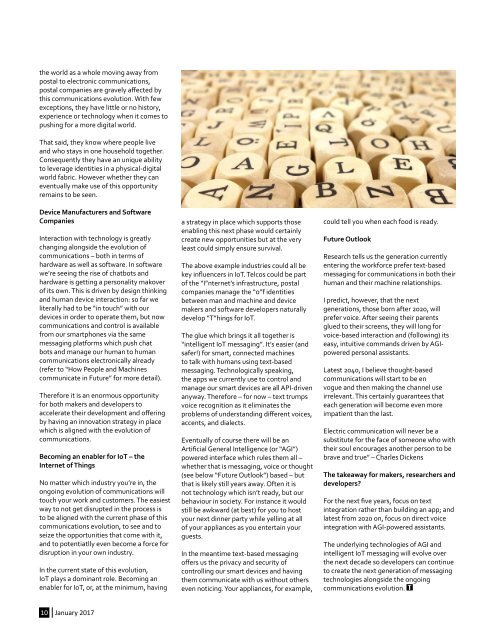Kingdom of Bahrain
TT_Jan17
TT_Jan17
You also want an ePaper? Increase the reach of your titles
YUMPU automatically turns print PDFs into web optimized ePapers that Google loves.
the world as a whole moving away from<br />
postal to electronic communications,<br />
postal companies are gravely affected by<br />
this communications evolution. With few<br />
exceptions, they have little or no history,<br />
experience or technology when it comes to<br />
pushing for a more digital world.<br />
That said, they know where people live<br />
and who stays in one household together.<br />
Consequently they have an unique ability<br />
to leverage identities in a physical-digital<br />
world fabric. However whether they can<br />
eventually make use <strong>of</strong> this opportunity<br />
remains to be seen.<br />
Device Manufacturers and S<strong>of</strong>tware<br />
Companies<br />
Interaction with technology is greatly<br />
changing alongside the evolution <strong>of</strong><br />
communications – both in terms <strong>of</strong><br />
hardware as well as s<strong>of</strong>tware. In s<strong>of</strong>tware<br />
we’re seeing the rise <strong>of</strong> chatbots and<br />
hardware is getting a personality makover<br />
<strong>of</strong> its own. This is driven by design thinking<br />
and human device interaction: so far we<br />
literally had to be “in touch” with our<br />
devices in order to operate them, but now<br />
communications and control is available<br />
from our smartphones via the same<br />
messaging platforms which push chat<br />
bots and manage our human to human<br />
communications electronically already<br />
(refer to “How People and Machines<br />
communicate in Future” for more detail).<br />
Therefore it is an enormous opportunity<br />
for both makers and developers to<br />
accelerate their development and <strong>of</strong>fering<br />
by having an innovation strategy in place<br />
which is aligned with the evolution <strong>of</strong><br />
communications.<br />
Becoming an enabler for IoT – the<br />
Internet <strong>of</strong> Things<br />
No matter which industry you’re in, the<br />
ongoing evolution <strong>of</strong> communications will<br />
touch your work and customers. The easiest<br />
way to not get disrupted in the process is<br />
to be aligned with the current phase <strong>of</strong> this<br />
communications evolution, to see and to<br />
seize the opportunities that come with it,<br />
and to potentiatlly even become a force for<br />
disruption in your own industry.<br />
In the current state <strong>of</strong> this evolution,<br />
IoT plays a dominant role. Becoming an<br />
enabler for IoT, or, at the minimum, having<br />
a strategy in place which supports those<br />
enabling this next phase would certainly<br />
create new opportunities but at the very<br />
least could simply ensure survival.<br />
The above example industries could all be<br />
key influencers in IoT. Telcos could be part<br />
<strong>of</strong> the “I”nternet’s infrastructure, postal<br />
companies manage the “o”f identities<br />
between man and machine and device<br />
makers and s<strong>of</strong>tware developers naturally<br />
develop “T”hings for IoT.<br />
The glue which brings it all together is<br />
“intelligent IoT messaging”. It’s easier (and<br />
safer!) for smart, connected machines<br />
to talk with humans using text-based<br />
messaging. Technologically speaking,<br />
the apps we currently use to control and<br />
manage our smart devices are all API-driven<br />
anyway. Therefore – for now – text trumps<br />
voice recognition as it eliminates the<br />
problems <strong>of</strong> understanding different voices,<br />
accents, and dialects.<br />
Eventually <strong>of</strong> course there will be an<br />
Artificial General Intelligence (or “AGI”)<br />
powered interface which rules them all –<br />
whether that is messaging, voice or thought<br />
(see below “Future Outlook”) based – but<br />
that is likely still years away. Often it is<br />
not technology which isn’t ready, but our<br />
behaviour in society. For instance it would<br />
still be awkward (at best) for you to host<br />
your next dinner party while yelling at all<br />
<strong>of</strong> your appliances as you entertain your<br />
guests.<br />
In the meantime text-based messaging<br />
<strong>of</strong>fers us the privacy and security <strong>of</strong><br />
controlling our smart devices and having<br />
them communicate with us without others<br />
even noticing. Your appliances, for example,<br />
could tell you when each food is ready.<br />
Future Outlook<br />
Research tells us the generation currently<br />
entering the workforce prefer text-based<br />
messaging for communications in both their<br />
human and their machine relationships.<br />
I predict, however, that the next<br />
generations, those born after 2020, will<br />
prefer voice. After seeing their parents<br />
glued to their screens, they will long for<br />
voice-based interaction and (following) its<br />
easy, intuitive commands driven by AGIpowered<br />
personal assistants.<br />
Latest 2040, I believe thought-based<br />
communications will start to be en<br />
vogue and then making the channel use<br />
irrelevant. This certainly guarantees that<br />
each generation will become even more<br />
impatient than the last.<br />
Electric communication will never be a<br />
substitute for the face <strong>of</strong> someone who with<br />
their soul encourages another person to be<br />
brave and true” – Charles Dickens<br />
The takeaway for makers, researchers and<br />
developers?<br />
For the next five years, focus on text<br />
integration rather than building an app; and<br />
latest from 2020 on, focus on direct voice<br />
integration with AGI-powered assistants.<br />
The underlying technologies <strong>of</strong> AGI and<br />
intelligent IoT messaging will evolve over<br />
the next decade so developers can continue<br />
to create the next generation <strong>of</strong> messaging<br />
technologies alongside the ongoing<br />
communications evolution.<br />
10 January 2017



